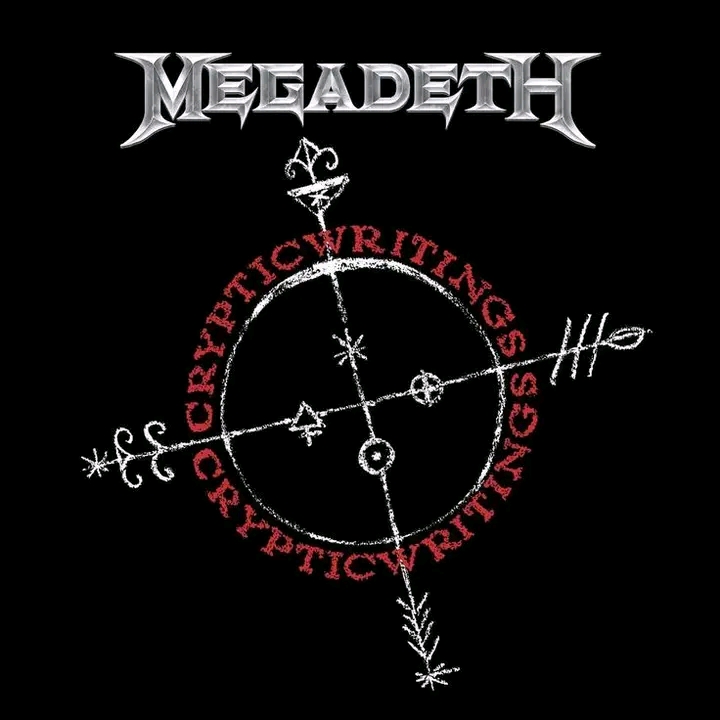Album Report
Megadeth’s seventh album, “Cryptic Writings,” has been poorly received and not well-received, but I believe it is a masterpiece that shows a different side of Megadeth. It will also be Nick Menza’s final album.
When Megadeth released their seventh studio album, Cryptic Writings, in June 1997, the initial reaction was far from the fanfare Dave Mustaine and company might have hoped for. Critics were lukewarm. Longtime thrash loyalists accused the band of selling out, and casual rock listeners often dismissed it as neither heavy enough for metal nor catchy enough for mainstream radio. It was, by many accounts at the time, not well received. Yet, nearly three decades later, Cryptic Writings stands as an overlooked gem in Megadeth’s catalog — a record that reveals new layers of artistry and risk-taking when stripped of the baggage of expectations.
More than just another entry in their discography, the album also carries historical weight as the last studio release to feature drummer Nick Menza, whose tenure with the band is remembered as one of Megadeth’s most creative and commercially successful eras. His departure marked the end of what many still call the “classic” lineup. That fact alone elevates Cryptic Writings into a significant chapter in Megadeth’s history.
A Shift in Sound
By the late 1990s, thrash metal’s dominance was waning. Bands that once defined the genre were experimenting with new directions to adapt to the changing musical landscape. Metallica had already gone down a more mainstream route with Load and Reload, and Pantera was pulling metal toward groove-driven heaviness. For Megadeth, Cryptic Writings became the laboratory for their own reinvention.
Unlike the relentless aggression of Peace Sells… but Who’s Buying? or the technical fireworks of Rust in Peace, this album embraced melody, streamlined song structures, and a more radio-friendly approach. Tracks like “Trust” and “Almost Honest” found rotation on rock stations and even broke into Billboard charts. But for many purist fans, the polished sound was a step too far from the thrash roots they loved.
In hindsight, though, this shift reveals Megadeth’s versatility. Songs like “Use the Man” — which starts with a haunting acoustic intro before exploding into electrified riffs — showcase Mustaine’s ability to blend vulnerability with ferocity. “She-Wolf”, with its piercing guitar harmonies and fiery solos, proved that the band hadn’t abandoned their technical edge. Even the more accessible tracks, like “Breadline” and “Mastermind”, hold up as strong examples of late-’90s heavy rock songwriting.
Nick Menza’s Final Bow
For many fans, Cryptic Writings is bittersweet because it marks the end of Nick Menza’s journey with Megadeth. Having joined in 1989, Menza became a cornerstone of the band’s classic era, driving albums like Rust in Peace, Countdown to Extinction, and Youthanasia. His drumming style combined speed, precision, and creativity — a rare blend that elevated Megadeth’s sound to another level.
On Cryptic Writings, Menza’s contributions shine throughout. The groove of “The Disintegrators” wouldn’t hit as hard without his relentless double-kick work. His nuanced fills on “Vortex” and “Sin” add color to songs that might otherwise have felt too polished. This was a drummer who knew how to balance technicality with feel, something that can’t be said for every player in the genre.
Sadly, Menza was let go from the band shortly after the album’s release due to health concerns, and though he remained active in music until his passing in 2016, Cryptic Writings became his final recorded statement with Megadeth. That fact alone makes the album essential listening for those who want to experience the full arc of Menza’s artistry.
Misunderstood in Its Time
Part of why Cryptic Writings was dismissed in 1997 was timing. The late ’90s were dominated by grunge’s lingering shadow and the rise of nu-metal, leaving traditional metal bands scrambling to find their place. Megadeth’s attempt to bridge mainstream appeal with heavy roots was bold, but it arrived in a climate that didn’t reward subtlety.
Looking back, however, the album plays less like a compromise and more like a document of a band stretching its wings. Mustaine himself has said in interviews that the record was an attempt to balance heaviness with accessibility. That balancing act may not have pleased everyone, but it demonstrated a willingness to evolve rather than repeat formulas.
Interestingly, some of the very songs once criticized for being too commercial have aged surprisingly well. “Trust”, with its dramatic buildup and crushing chorus, remains a fan favorite and is often included in live sets. Its blend of melody and power seems far less out of place today, especially in a world where metal and rock frequently overlap with mainstream sensibilities.
A Masterpiece in Disguise
To call Cryptic Writings a masterpiece may still spark debate among die-hard fans, but there’s no denying its importance in Megadeth’s story. It captures a band in transition, wrestling with identity while still delivering sharp musicianship and memorable songwriting. It also serves as a poignant farewell for Nick Menza, whose drumming remains one of the album’s strongest assets.
Revisiting Cryptic Writings with fresh ears strips away the unfair expectations of its release era. Instead of asking whether it was “thrash enough” or “commercial enough,” listeners can appreciate it for what it is: a bold, textured, and deeply personal entry in Megadeth’s catalog. Far from being a misstep, it’s a record that reveals its brilliance over time, rewarding those willing to give it another chance.
For those who see only the classics like Rust in Peace or Countdown to Extinction as Megadeth’s defining works, Cryptic Writings may never change their minds. But for listeners who embrace evolution and nuance, this seventh album stands as proof that Megadeth had more to offer than thrash alone. In its melodies, grooves, and experimentation lies a masterpiece hiding in plain sight.
